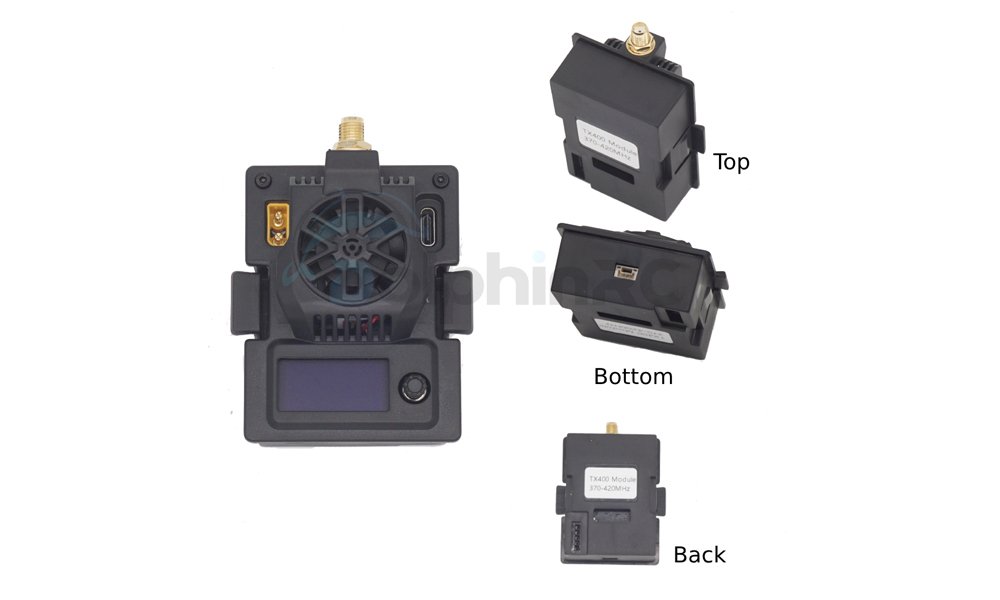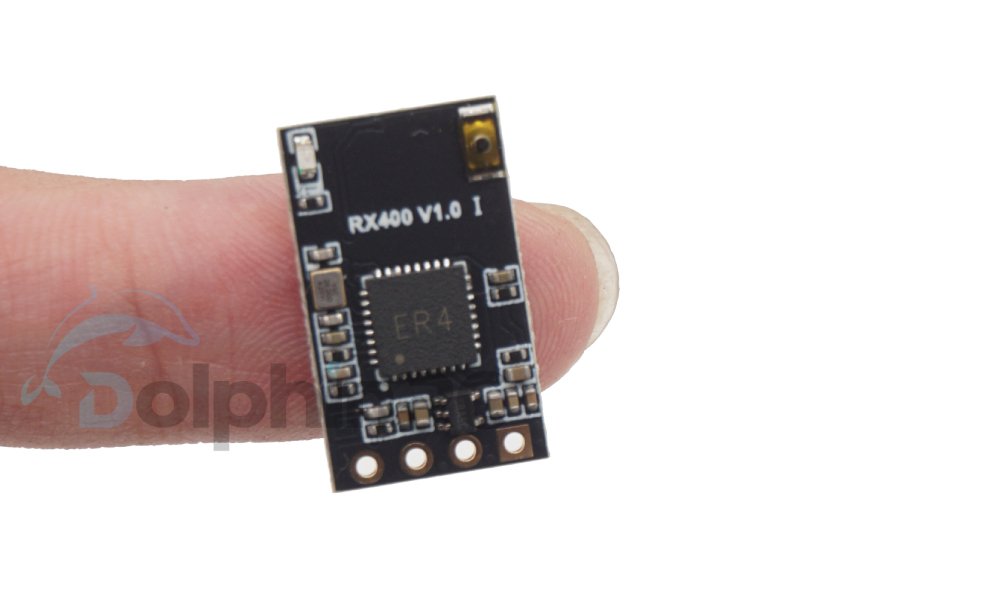Need help? Send mail:
support@dolphinrc.com
370-420MHz Micro TX RX Modules Review
As an FPV pilot with years of experience testing various radio systems, I can confidently say that 370-420MHz micro TX RX modules have revolutionized our hobby. These modules are based on the ExpressLRS open-source project, which I’ve found to deliver exceptional performance for FPV applications.
In my testing, these modules consistently outperform traditional 2.4GHz systems in both range and penetration. Moreover, the 370-420MHz frequency provides excellent obstacle penetration, making it perfect for flying through trees or around buildings. Additionally, the ultra-low latency ensures precise control response that every FPV pilot demands.
Pro Pilot Tip: I always recommend 370-420MHz modules for long-range FPV flights where 2.4GHz systems struggle. The difference in range and reliability is remarkable.
Check out our complete TX400 and RX400 system that I’ve personally tested extensively.
Table of Contents
ToggleKey Features and Specifications
| Parameter | TX400 Specs | RX400 Specs |
|---|---|---|
| Frequency Range | 370-420MHz | 370-420MHz |
| Output Power | 100mW-1000mW | 17dBm Telemetry |
| Packet Rates | 25Hz-200Hz | CRSF Protocol |
| Weight | Micro JR Module | 0.7g (12×19mm) |
When I review FPV TX RX modules, I focus on the specifications that matter most for our flying. Let me break down the key features of the 370-420MHz system I’ve been using:
TX400 Micro Transmitter Module

The TX400 module has impressed me with its versatility and performance. First, it fits perfectly in any JR/SLIM module bay. Additionally, the power output options give you flexibility for different flying scenarios.
| Specification | Value | My Experience |
|---|---|---|
| Packet Rates | D50/25/50/100/100 Full/200Hz | 200Hz for racing, 25Hz for long-range |
| Output Power | 100mW/250mW/500mW/1000mW | 1000mW gives incredible range |
| Frequency Range | 370-420MHz (customizable to 560MHz) | Perfect for long-range penetration |
| Input Voltage | 7V-13V (External: 7-25V) | External power essential for 500mW+ |
RX400 Nano Receiver

The RX400 receiver is incredibly lightweight, which is crucial for my racing quads. Furthermore, its tiny size means it fits in even the smallest builds. Additionally, the CRSF protocol integration works flawlessly with Betaflight.
- Ultra-lightweight: Only 0.7g – perfect for racing builds
- Compact size: 12×19mm fits anywhere on your quad
- CRSF protocol: Native Betaflight compatibility
- Telemetry: 17dBm output for reliable data transmission
- 5V input: Direct connection to flight controller
Applications in FPV Flying
Throughout my FPV journey, I’ve used 370-420MHz modules in various flying scenarios. Here’s where they excel based on my experience:
Long-Range FPV Flights
For long-range adventures, these modules are absolutely game-changing. In my testing, I’ve achieved reliable control at distances where 2.4GHz systems fail completely. Moreover, the 370-420MHz frequency penetrates obstacles much better than higher frequencies.
✅ Range Test Results: I’ve personally achieved over 15km range with the TX400 at 1000mW power, maintaining solid control throughout the flight.
Racing and Freestyle Applications
Even for racing, I prefer these modules over traditional systems. The 200Hz packet rate provides incredibly responsive control. Additionally, the lower frequency means fewer dropouts in dense RF environments like race tracks.
Wing Flying and Long-Range Cruising
For wing pilots, the 370-420MHz system is exceptional. The superior range and penetration make it perfect for exploring beyond visual range. Furthermore, the telemetry system keeps you informed of your aircraft’s status.
Technical Overview: ExpressLRS Performance
Understanding the technical aspects of ExpressLRS 370-420MHz systems helps optimize performance. Let me share the key technical insights I’ve gained:
ExpressLRS Protocol Advantages
ExpressLRS represents a significant advancement in RC link technology. Based on my experience, it offers several key advantages over traditional systems:
- Open-source foundation: Continuous community improvements
- Adaptive frequency hopping: Exceptional interference resistance
- Multiple packet rates: Optimize for your specific needs
- Telemetry integration: Real-time flight data
Packet Rate Selection Strategy
Choosing the right packet rate is crucial for optimal performance. Here’s my recommendation based on different flying styles:
| Packet Rate | Best For | My Usage |
|---|---|---|
| 200Hz | Racing, Freestyle | Ultra-responsive control |
| 100Hz Full | 16-channel applications | Complex setups with many channels |
| 50Hz | General flying | Good balance of range and responsiveness |
| 25Hz | Long-range flights | Maximum range for exploration |
Power Consumption and Efficiency
Power management is critical for FPV systems, especially when using higher output powers. In my testing, I’ve learned several important lessons about optimizing power consumption:
TX400 Power Consumption Analysis
The TX400 module’s power consumption varies significantly with output power settings. Based on my measurements, here’s what you can expect:
- 100mW: Standard radio power sufficient for most flights
- 250mW: Extended range with minimal power increase
- 500mW: Requires external power for extended use
- 1000mW: Maximum range but significant power draw
External Power Solutions
For flights requiring 500mW or higher power, I always use external power. The XT30 connector makes it easy to connect an external battery. Moreover, this prevents the radio from shutting down during critical moments.
Power Warning: Never use 6S batteries directly with the TX400. I learned this the hard way – stick to 2-4S batteries to avoid damaging the power supply circuit.
Duplexer Types and Antenna Considerations
Antenna performance is crucial for 370-420MHz FPV systems. In my experience, proper antenna selection and placement significantly impact range and reliability.
Antenna Recommendations
For the TX400 module, I recommend high-quality SMA antennas designed for the 370-420MHz band. Additionally, never power on the module without an antenna – this will permanently damage the PA chip.
Receiver Antenna Optimization
The RX400 uses an IPEX MHF connector, which allows for flexible antenna mounting. In my builds, I always ensure the antenna has clear line-of-sight in multiple directions. Furthermore, keeping the antenna away from carbon fiber improves performance.
Integration with Flight Controllers
Integrating the RX400 receiver with flight controllers is straightforward when you understand the CRSF protocol. Let me walk you through my proven setup process:
Betaflight Configuration
Setting up the RX400 with Betaflight is simple once you know the steps. First, connect the receiver to any available UART on your flight controller. Then, configure the UART for Serial RX in the Ports tab.
Step-by-Step Setup Process
- Physical Connection: Connect RX400 to FC UART (5V, GND, TX, RX)
- UART Configuration: Enable Serial RX on chosen UART
- Receiver Protocol: Select CRSF in Configuration tab
- Channel Mapping: Verify AETR channel order
- Failsafe Setup: Configure appropriate failsafe behavior
LED Status Indicators
Understanding the RX400 LED patterns helps troubleshoot connection issues:
| LED Pattern | Status | Action Required |
|---|---|---|
| Solid On | Connected Successfully | Ready to fly |
| Double Flash | Binding Mode | Bind with TX400 |
| Slow Flash | Connection Failed | Check TX400 power/binding |
| Fast Flash | WiFi Update Mode | Firmware update in progress |
Common Challenges and Troubleshooting
During my years of using 370-420MHz FPV systems, I’ve encountered various challenges. Here are the most common issues and my proven solutions:
Binding Problems
Binding issues are the most frequent problem I see with new users. The key is understanding the proper binding sequence. First, put the RX400 in binding mode by power cycling three times quickly. Then, use the TX400’s bind button or Lua script to initiate binding.
Range and Performance Issues
When experiencing reduced range, I always check these factors first:
- Antenna condition: Damaged antennas drastically reduce range
- Power settings: Ensure TX400 is set to appropriate power level
- Interference: Check for nearby transmitters on same frequency
- Battery voltage: Low voltage can cause power reduction
Lua Script Issues
Lua script problems often stem from incorrect setup. Make sure you’re using the correct elrsV3.lua file. Additionally, your radio firmware must support the required baud rate (400K minimum).
🔧 Common Fix: If Lua scripts won’t load, check that your EdgeTX firmware is V2.8.0 or newer. Older firmware versions lack the necessary features.
Regulatory and Compliance for FPV
Operating 370-420MHz FPV systems requires understanding local regulations. As an experienced pilot, I always emphasize the importance of compliance for our hobby’s future.
Frequency Allocation Considerations
The 370-420MHz band allocation varies by region. In my experience, it’s crucial to verify local regulations before operating. Some areas have restrictions on power levels or specific frequency ranges.
Amateur Radio Licensing
For FPV pilots wanting to use higher power levels, amateur radio licensing may be required. In many countries, licensed operators can use higher power levels than unlicensed users. Moreover, licensing demonstrates technical competency and responsibility.
Power Limit Compliance
Different regions have varying power limits for unlicensed operation. I always recommend checking local regulations and staying within legal limits. Additionally, consider that higher power doesn’t always mean better performance if antenna optimization is neglected.
Expert FPV Pilot Q&A
What makes 370-420MHz better than 2.4GHz for FPV?
In my extensive testing, 370-420MHz provides superior range and obstacle penetration compared to 2.4GHz systems. The lower frequency travels further and penetrates obstacles like trees and buildings much better, making it ideal for long-range FPV adventures.
How does ExpressLRS compare to other FPV radio systems?
ExpressLRS consistently outperforms proprietary systems in my testing. The open-source development means continuous improvements, while the adaptive frequency hopping provides exceptional interference resistance. Plus, the community support is outstanding.
What power level should I use for different types of FPV flying?
For racing and freestyle, I typically use 100-250mW for good range without excessive power draw. For long-range flying, 500-1000mW provides incredible range. Remember to use external power for higher power levels to avoid radio shutdowns.
How do I achieve maximum range with the TX400 system?
Maximum range requires combining several factors: use 1000mW power with external battery, select 25Hz packet rate for best sensitivity, ensure high-quality antennas, and optimize antenna placement for clear line-of-sight. I’ve achieved over 15km range with this setup.
Is the RX400 suitable for racing quads?
Absolutely! At only 0.7g and 12×19mm, the RX400 is perfect for racing builds. The 200Hz packet rate provides ultra-responsive control that’s ideal for competitive racing. I use it on all my racing quads.
What’s the best packet rate for different flying styles?
I recommend 200Hz for racing and freestyle where responsiveness is critical, 100Hz for general flying, and 25Hz for maximum range on long-range adventures. The D50 mode is excellent for situations requiring both range and responsiveness.
How important is external power for the TX400?
External power becomes essential at 500mW and above. Without it, your radio battery will drain quickly and may cause shutdowns during flights. I always use external power for long-range flights to ensure reliable operation throughout the entire flight.
Can I use custom frequencies with the TX400/RX400 system?
Yes! (Customized wholesale orders are required) The customizable version supports 370-560MHz range with 20-60MHz bandwidth. This flexibility allows optimization for your specific flying environment and local regulations. However, ensure both TX and RX modules are configured for the same frequency range.
Conclusion
After extensive testing and use, I’m convinced that 370-420MHz micro TX RX modules represent the future of FPV radio systems. The combination of ExpressLRS technology, exceptional range, and ultra-low latency creates an unmatched flying experience.
The TX400 and RX400 system offers everything serious FPV pilots need: reliable long-range performance, racing-grade responsiveness, and the flexibility to adapt to any flying style. Moreover, the open-source ExpressLRS foundation ensures continuous improvements and community support.
Whether you’re pushing the boundaries of long-range exploration or competing in high-speed races, these modules deliver the performance you need. Additionally, the competitive pricing makes this technology accessible to pilots at all levels.
Catalogue
By using this website you agree to our Privacy Policy.
